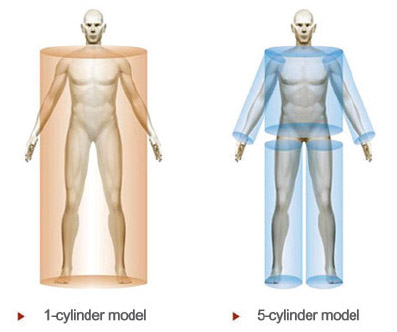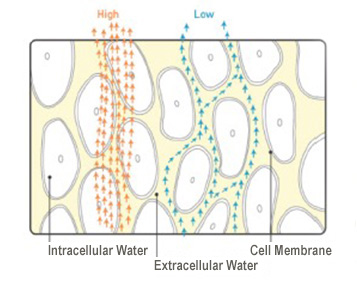Water, protein, minerals, and fat are the primary components of the human body, and the ratio of these elements present at any one time directly relate to the status of our health and performance. Applying quantitative analysis, the InBody scan captures your picture of health.
InBody utilizes the BIA method
Gaining widespread recognition in the late 1960’s, Bioelectrical Impedance Analysis (BIA) measures body water via the impedance index. Based on the fact that the human body is made up of primarily water and that the level of electric resistivity – or resistance – varies according to the amount of water present, obtaining the impedance index can be achieved through the analysis of a small alternating current as it travels through the body.
Overcoming the limitations of early BIA
Motivated through understanding the cause of BIA’s inaccuracy as a limitation in technology, the solution stood to be realized through technological innovation. In 1996, InBody Co., Ltd. developed the world’s first BIA body composition analyzer capable of both direct segmental measurement and simultaneous multi-frequency measurement.
Learn more about BIA in our technical article »
Direct Segmental Measurement
InBody uses direct segmental measurement, a patented technology, to measure the body as five separate cylinders: four limbs and the torso. Distinguishing these five separate segments is critical, as the torso accounts for as much as 50% of total body weight and has different cross-sectional areas than the arms and legs.

Accuracy through Multi-Frequency Measurement
InBody’s simultaneous multi-frequency measurement method accurately analyzes both intracellular and extracellular water by using multiple broadband frequencies in the range of 1kHz – 1000kHz. The ability of current to pass through cell membranes varies according to its frequency. Using only a single frequency of 50kHz, the accuracy of earlier BIA methods were compromised due to their inability to distinguish between intracellular and extracellular body water. With multi-frequency technology, InBody overcame this limitation reliant on a constant proportional formula to calculate total body water through estimation.

8-Point Tetra-Polar System with Patented Thumb Sensor
By taking structural characteristics of the human body into consideration, InBody uses 2 current and voltage electrodes for each hand and foot, requiring the user to grasp and step on to a total of 8 points of contact. This exclusive tetra-polar 8-point design ensures that measurements repeatedly start at fixed points – the wrists and the ankles – promoting the utmost accuracy and reproducibility.

Accounting for Special Body Types without the Use of Empirical Estimations
Statistical variables, such as gender, age, ethnicity, and body type, are factors commonly used in formulas for calculating body composition. They were used out of necessity to compensate for the inaccuracies of earlier methodologies. However, since InBody features direct segmental impedance measurement, simultaneous multi-frequency measurement, and 8-point tactile sensor system, body composition can now be derived accurately without the use of any empirical estimations.
Today, the advancement of BIA technology brought to market by InBody has won global acclaim by experts in multiple disciplines due to its innovation, precision, safety of use, and providing of accurate, personalized results. Having established a correlation of 98.4% with DEXA, this medical-grade equipment is relied upon across such various fields as sports performance, the nutritional sciences, preventive medicine, nephrology, rehabilitation therapy, and obesity intervention. InBody is trusted worldwide both in clinical and research settings where the monitoring of the compositional elements of the human body is vital.

The BIA technology used in the InBody system is a valid tool for the assessment of total body composition, particularly for the qualification of lean body mass. For further reading and validation, please browse the following studies:
BIA Studies
Correlation of Whole-Body Impedance with Total Body Water Volume »
Hoffer, Meador, & Simpson (1969)
Estimation of Body Fluid Volumes Using Tetrapolar Bioelectrical Impedance Measurements »
Lukaski & Bolonchuk (1988)
Determination of Body Fluids by the Impedance Technique »
Schoeller & Kushner (1989)
Assessment of Body Composition by Bioelectrial Impedance in a Population Aged > 60 y1,2
Deurenberg, van der Kooij, Evers, & Hulshof (1990)
Bioelectrical Impedance Analysis: A Review of Principles and Applications »
Kushner (1992)
Validity: A Study of the Eight Tactile Point Bioelectrical Impedance using the DXA in Body Fat Percentage Assessment »
Rosen, Dunn, Walker, Downs, Jones, Danhoff, Davidson, & Stapleton (2014)
InBody Studies
Ability of New Octapolar Bioimpedance Spectroscopy Analyzers to Predict 4-Component-Model Percentage Body Fat in Hispanic, Black and White Adults1-3»
Gibson, Holmes, Desautels, Edmonds, & Nuudi (2008)
Estimating Survival in Patients with Cancer Receiving Palliative Care: Is Analysis of Body Composition Using Bioimpedance Helpful? »
Crawford, Robinson, Hunt, Piller, & Esterman (2009)
Cross-Validation of Bioelectrical Impedance Analysis for the Assessment of Body Composition in a Representative Sample of 6- to 13-Year-Old Children »
Kriemler, Puder, Zahner, Roth, Braun-Fahrlander, & Bedogni (2009)
Cross-Calibration of Multi-Frequency Bioelectrical Impedance Analysis with Eight-Point Tactile Electrodes and Dual-Energy X-Ray Absorptiometry for Assessment of Body Composition in Healthy Children Aged 6-18 Years »
Lim, Hwang, Lee, Kim, Park, Jeong, & Cheon (2009)
Assessment of Body Composition in Peritoneal Dialysis Patients Using Bioelectrical Impedance and Dual-Energy X-Ray Absorptiometry »
Furstenberg & Davenport (2011)
Accuracy of Direct Segmental Multi-Frequency Bioimpedance Analysis in the Assessment of Total Body and Segmental Body Composition in Middle-Aged Adult Population »
Ling, de Craen, Slagboom, Gunn, Stokkel, Westendorp, & Maier (2011)
Body Composition Measurements Determined by Air Displacement Plethysmography and Eight-Polar Bioelectrical Impedance Analysis are Equivalent in African American College Students »
So, Swaeringin, Crooms, Lee, Choi, Dail, Melton, Fuller, & Ha (2012)
The Validity of Multifrequency Bioelectrical Impedance Measures to Detect Changes in the Hydration Status of Wrestlers During Acute Dehydration and Rehydration »
Utter, McAnulty, Riha, Pratt, & Grose (2012)
Impact of Non-Training Physical Activity on Menstrual Dysfunction in Collegiate Cross-Country Runners »
Nell, Sorensen, Albrecht, Kompelien, & Aschenbrenner (2014)
Comparison of Four Different Methods for the Determination of Body Composition against Air Displacement Plethysmography »
Parra, Diaz, & Bilbao (2014)
